Innovation and Entrepreneurship
VerifiedAdded on 2023/06/09
|7
|1335
|225
AI Summary
This article discusses the opportunities for creating eco-store goods and services, and how Malcolm started his business as a strategic entrepreneurship. It also talks about the benefits of eco-friendly products and how they contribute to sustainability. The article includes references to support the information provided.
Contribute Materials
Your contribution can guide someone’s learning journey. Share your
documents today.
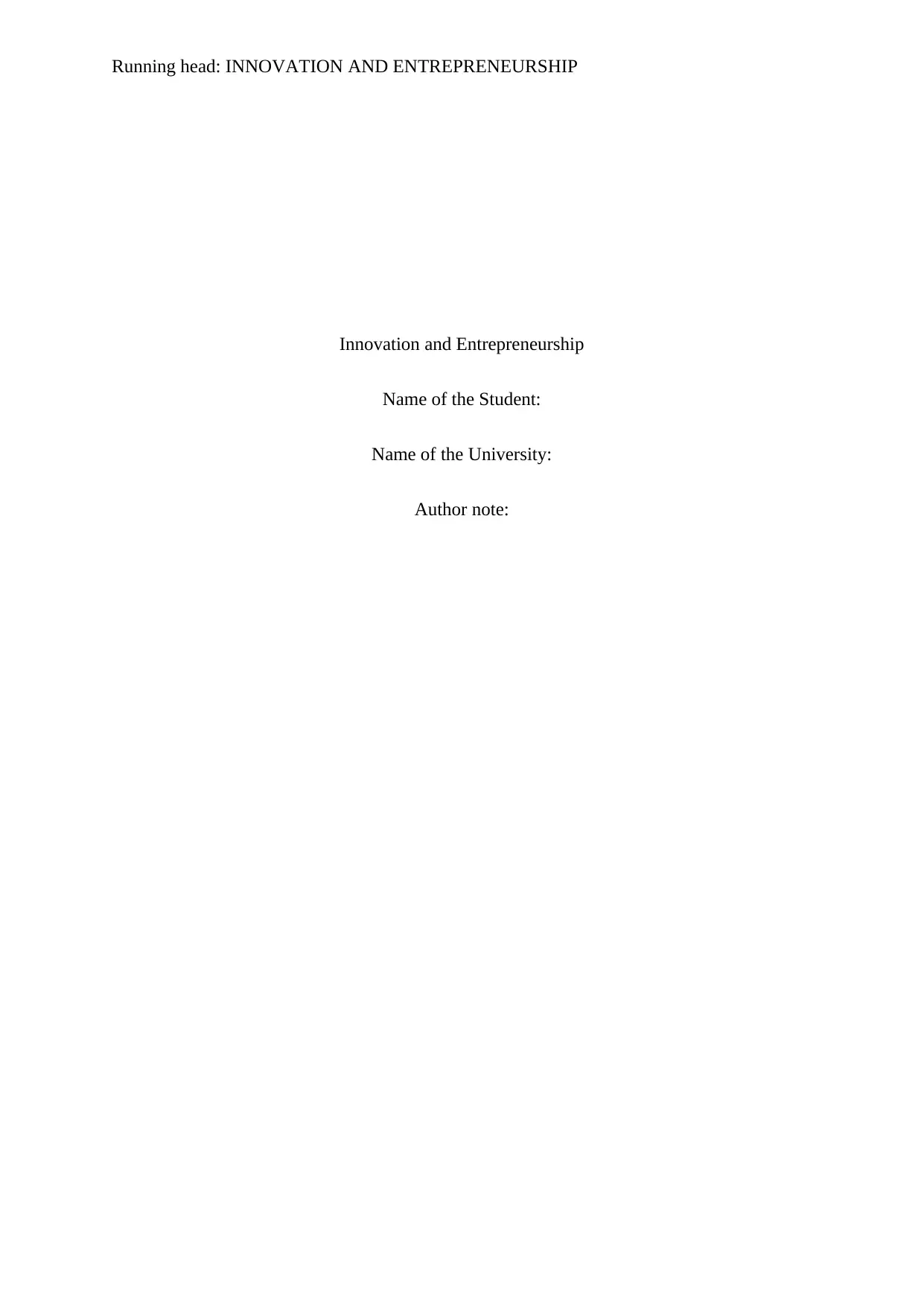
Running head: INNOVATION AND ENTREPRENEURSHIP
Innovation and Entrepreneurship
Name of the Student:
Name of the University:
Author note:
Innovation and Entrepreneurship
Name of the Student:
Name of the University:
Author note:
Secure Best Marks with AI Grader
Need help grading? Try our AI Grader for instant feedback on your assignments.
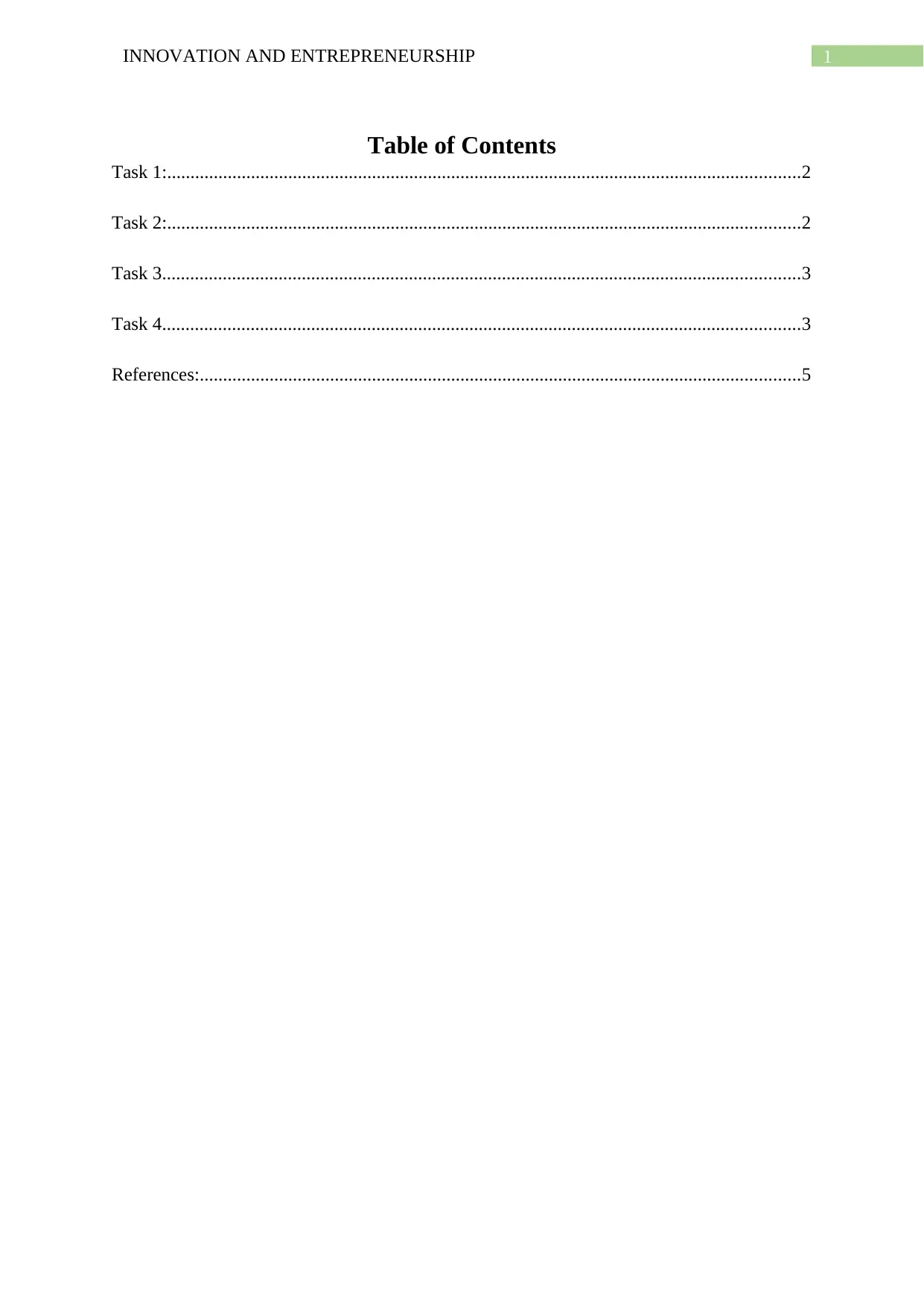
1INNOVATION AND ENTREPRENEURSHIP
Table of Contents
Task 1:........................................................................................................................................2
Task 2:........................................................................................................................................2
Task 3.........................................................................................................................................3
Task 4.........................................................................................................................................3
References:.................................................................................................................................5
Table of Contents
Task 1:........................................................................................................................................2
Task 2:........................................................................................................................................2
Task 3.........................................................................................................................................3
Task 4.........................................................................................................................................3
References:.................................................................................................................................5
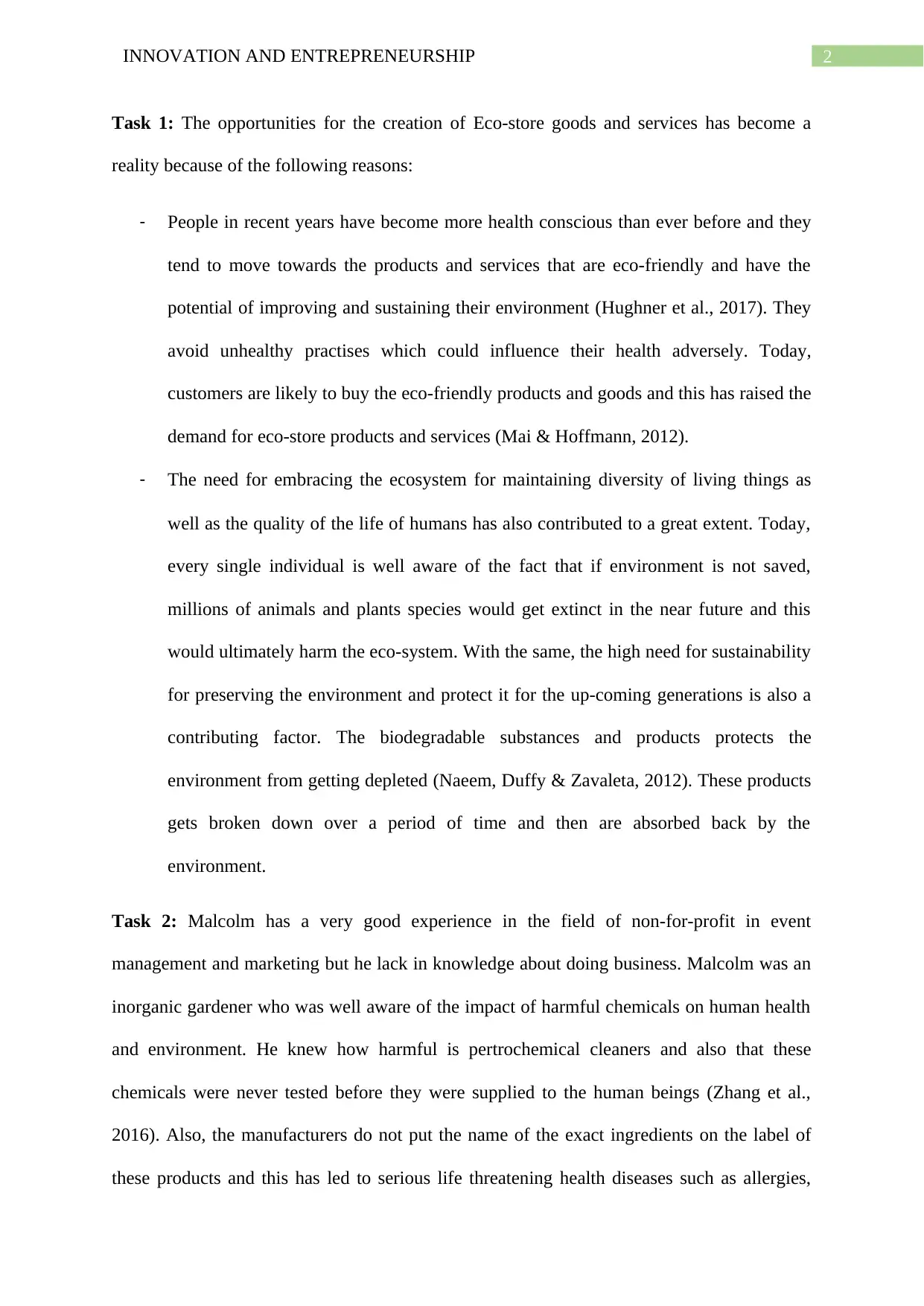
2INNOVATION AND ENTREPRENEURSHIP
Task 1: The opportunities for the creation of Eco-store goods and services has become a
reality because of the following reasons:
- People in recent years have become more health conscious than ever before and they
tend to move towards the products and services that are eco-friendly and have the
potential of improving and sustaining their environment (Hughner et al., 2017). They
avoid unhealthy practises which could influence their health adversely. Today,
customers are likely to buy the eco-friendly products and goods and this has raised the
demand for eco-store products and services (Mai & Hoffmann, 2012).
- The need for embracing the ecosystem for maintaining diversity of living things as
well as the quality of the life of humans has also contributed to a great extent. Today,
every single individual is well aware of the fact that if environment is not saved,
millions of animals and plants species would get extinct in the near future and this
would ultimately harm the eco-system. With the same, the high need for sustainability
for preserving the environment and protect it for the up-coming generations is also a
contributing factor. The biodegradable substances and products protects the
environment from getting depleted (Naeem, Duffy & Zavaleta, 2012). These products
gets broken down over a period of time and then are absorbed back by the
environment.
Task 2: Malcolm has a very good experience in the field of non-for-profit in event
management and marketing but he lack in knowledge about doing business. Malcolm was an
inorganic gardener who was well aware of the impact of harmful chemicals on human health
and environment. He knew how harmful is pertrochemical cleaners and also that these
chemicals were never tested before they were supplied to the human beings (Zhang et al.,
2016). Also, the manufacturers do not put the name of the exact ingredients on the label of
these products and this has led to serious life threatening health diseases such as allergies,
Task 1: The opportunities for the creation of Eco-store goods and services has become a
reality because of the following reasons:
- People in recent years have become more health conscious than ever before and they
tend to move towards the products and services that are eco-friendly and have the
potential of improving and sustaining their environment (Hughner et al., 2017). They
avoid unhealthy practises which could influence their health adversely. Today,
customers are likely to buy the eco-friendly products and goods and this has raised the
demand for eco-store products and services (Mai & Hoffmann, 2012).
- The need for embracing the ecosystem for maintaining diversity of living things as
well as the quality of the life of humans has also contributed to a great extent. Today,
every single individual is well aware of the fact that if environment is not saved,
millions of animals and plants species would get extinct in the near future and this
would ultimately harm the eco-system. With the same, the high need for sustainability
for preserving the environment and protect it for the up-coming generations is also a
contributing factor. The biodegradable substances and products protects the
environment from getting depleted (Naeem, Duffy & Zavaleta, 2012). These products
gets broken down over a period of time and then are absorbed back by the
environment.
Task 2: Malcolm has a very good experience in the field of non-for-profit in event
management and marketing but he lack in knowledge about doing business. Malcolm was an
inorganic gardener who was well aware of the impact of harmful chemicals on human health
and environment. He knew how harmful is pertrochemical cleaners and also that these
chemicals were never tested before they were supplied to the human beings (Zhang et al.,
2016). Also, the manufacturers do not put the name of the exact ingredients on the label of
these products and this has led to serious life threatening health diseases such as allergies,
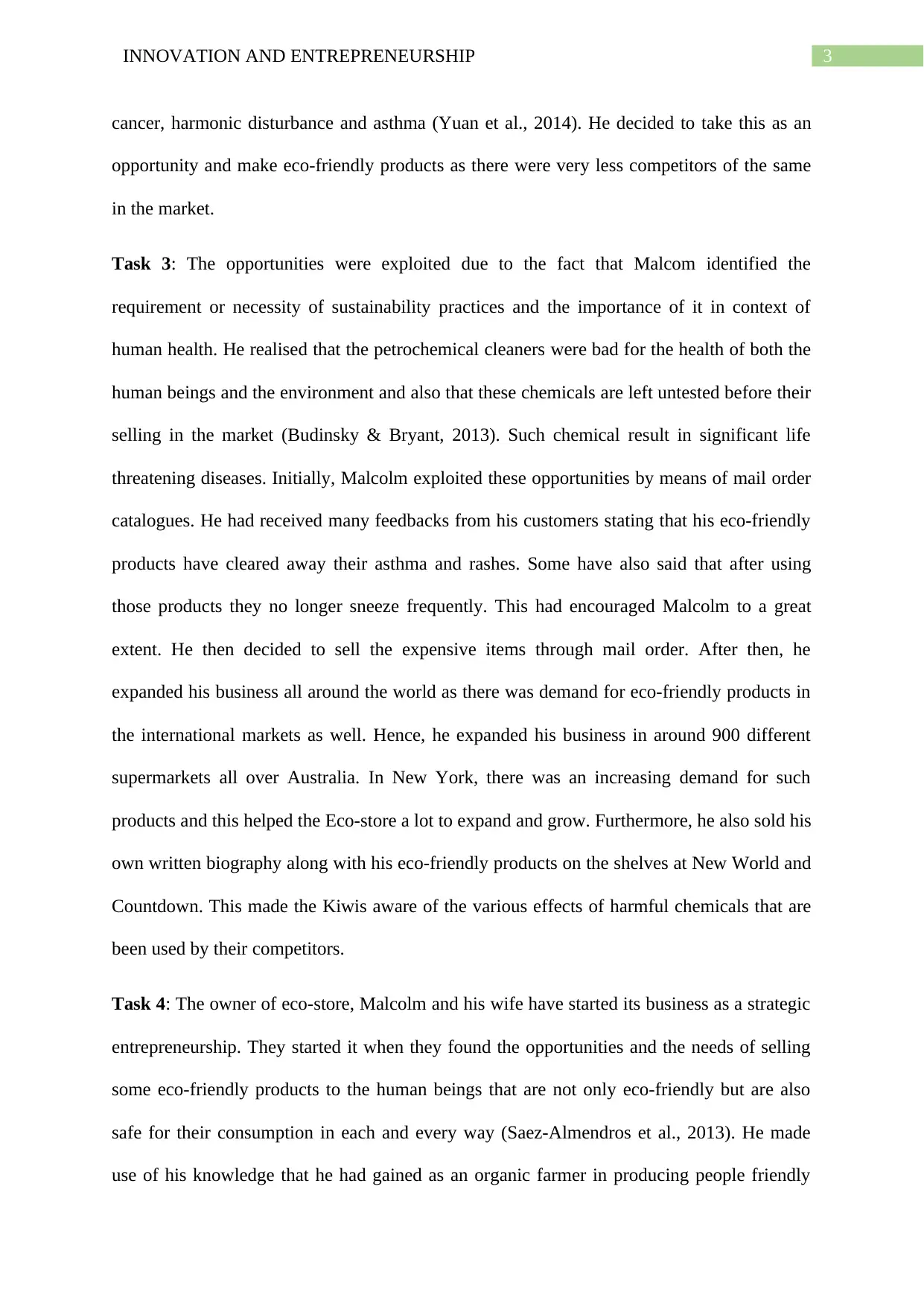
3INNOVATION AND ENTREPRENEURSHIP
cancer, harmonic disturbance and asthma (Yuan et al., 2014). He decided to take this as an
opportunity and make eco-friendly products as there were very less competitors of the same
in the market.
Task 3: The opportunities were exploited due to the fact that Malcom identified the
requirement or necessity of sustainability practices and the importance of it in context of
human health. He realised that the petrochemical cleaners were bad for the health of both the
human beings and the environment and also that these chemicals are left untested before their
selling in the market (Budinsky & Bryant, 2013). Such chemical result in significant life
threatening diseases. Initially, Malcolm exploited these opportunities by means of mail order
catalogues. He had received many feedbacks from his customers stating that his eco-friendly
products have cleared away their asthma and rashes. Some have also said that after using
those products they no longer sneeze frequently. This had encouraged Malcolm to a great
extent. He then decided to sell the expensive items through mail order. After then, he
expanded his business all around the world as there was demand for eco-friendly products in
the international markets as well. Hence, he expanded his business in around 900 different
supermarkets all over Australia. In New York, there was an increasing demand for such
products and this helped the Eco-store a lot to expand and grow. Furthermore, he also sold his
own written biography along with his eco-friendly products on the shelves at New World and
Countdown. This made the Kiwis aware of the various effects of harmful chemicals that are
been used by their competitors.
Task 4: The owner of eco-store, Malcolm and his wife have started its business as a strategic
entrepreneurship. They started it when they found the opportunities and the needs of selling
some eco-friendly products to the human beings that are not only eco-friendly but are also
safe for their consumption in each and every way (Saez-Almendros et al., 2013). He made
use of his knowledge that he had gained as an organic farmer in producing people friendly
cancer, harmonic disturbance and asthma (Yuan et al., 2014). He decided to take this as an
opportunity and make eco-friendly products as there were very less competitors of the same
in the market.
Task 3: The opportunities were exploited due to the fact that Malcom identified the
requirement or necessity of sustainability practices and the importance of it in context of
human health. He realised that the petrochemical cleaners were bad for the health of both the
human beings and the environment and also that these chemicals are left untested before their
selling in the market (Budinsky & Bryant, 2013). Such chemical result in significant life
threatening diseases. Initially, Malcolm exploited these opportunities by means of mail order
catalogues. He had received many feedbacks from his customers stating that his eco-friendly
products have cleared away their asthma and rashes. Some have also said that after using
those products they no longer sneeze frequently. This had encouraged Malcolm to a great
extent. He then decided to sell the expensive items through mail order. After then, he
expanded his business all around the world as there was demand for eco-friendly products in
the international markets as well. Hence, he expanded his business in around 900 different
supermarkets all over Australia. In New York, there was an increasing demand for such
products and this helped the Eco-store a lot to expand and grow. Furthermore, he also sold his
own written biography along with his eco-friendly products on the shelves at New World and
Countdown. This made the Kiwis aware of the various effects of harmful chemicals that are
been used by their competitors.
Task 4: The owner of eco-store, Malcolm and his wife have started its business as a strategic
entrepreneurship. They started it when they found the opportunities and the needs of selling
some eco-friendly products to the human beings that are not only eco-friendly but are also
safe for their consumption in each and every way (Saez-Almendros et al., 2013). He made
use of his knowledge that he had gained as an organic farmer in producing people friendly
Secure Best Marks with AI Grader
Need help grading? Try our AI Grader for instant feedback on your assignments.
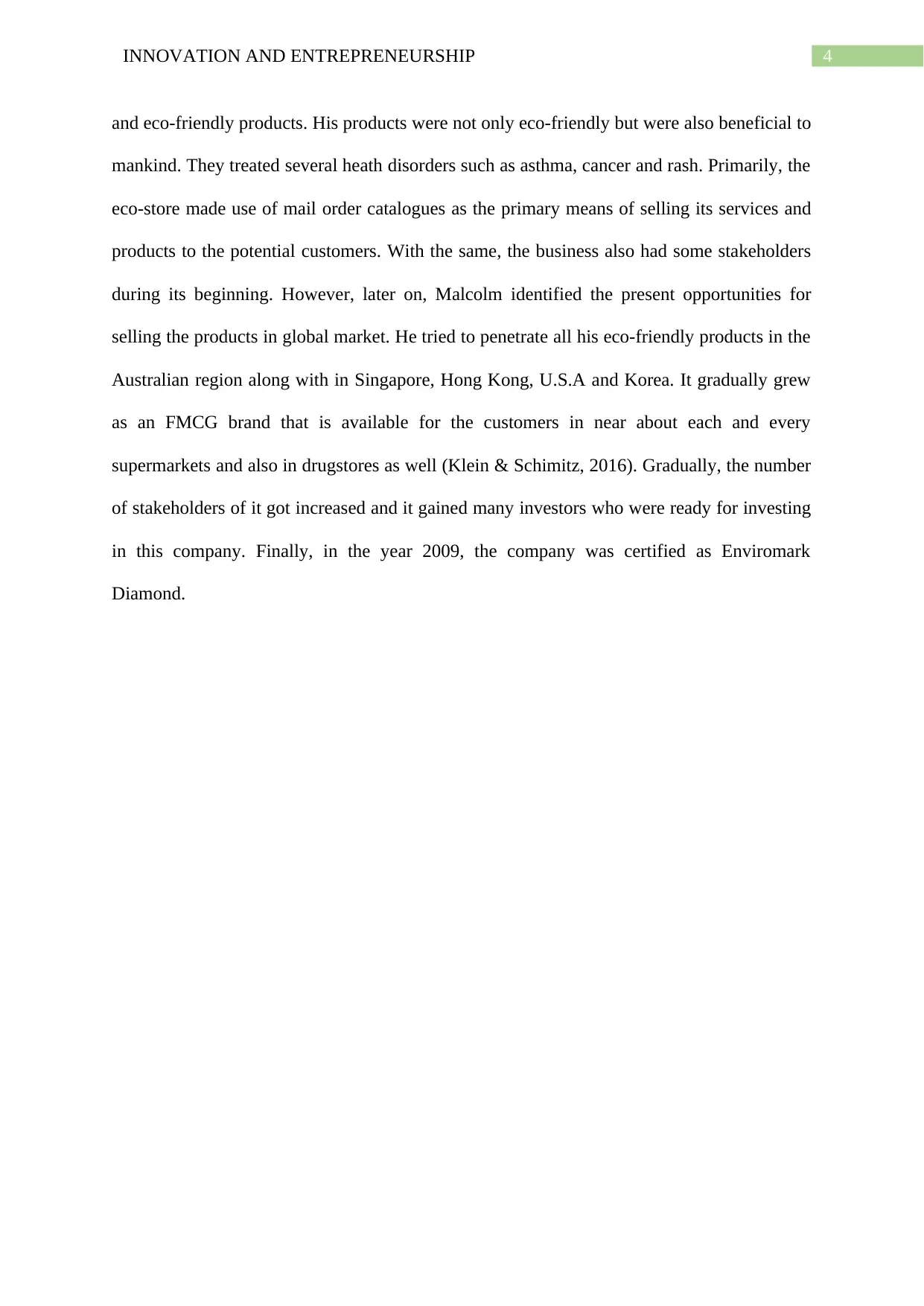
4INNOVATION AND ENTREPRENEURSHIP
and eco-friendly products. His products were not only eco-friendly but were also beneficial to
mankind. They treated several heath disorders such as asthma, cancer and rash. Primarily, the
eco-store made use of mail order catalogues as the primary means of selling its services and
products to the potential customers. With the same, the business also had some stakeholders
during its beginning. However, later on, Malcolm identified the present opportunities for
selling the products in global market. He tried to penetrate all his eco-friendly products in the
Australian region along with in Singapore, Hong Kong, U.S.A and Korea. It gradually grew
as an FMCG brand that is available for the customers in near about each and every
supermarkets and also in drugstores as well (Klein & Schimitz, 2016). Gradually, the number
of stakeholders of it got increased and it gained many investors who were ready for investing
in this company. Finally, in the year 2009, the company was certified as Enviromark
Diamond.
and eco-friendly products. His products were not only eco-friendly but were also beneficial to
mankind. They treated several heath disorders such as asthma, cancer and rash. Primarily, the
eco-store made use of mail order catalogues as the primary means of selling its services and
products to the potential customers. With the same, the business also had some stakeholders
during its beginning. However, later on, Malcolm identified the present opportunities for
selling the products in global market. He tried to penetrate all his eco-friendly products in the
Australian region along with in Singapore, Hong Kong, U.S.A and Korea. It gradually grew
as an FMCG brand that is available for the customers in near about each and every
supermarkets and also in drugstores as well (Klein & Schimitz, 2016). Gradually, the number
of stakeholders of it got increased and it gained many investors who were ready for investing
in this company. Finally, in the year 2009, the company was certified as Enviromark
Diamond.
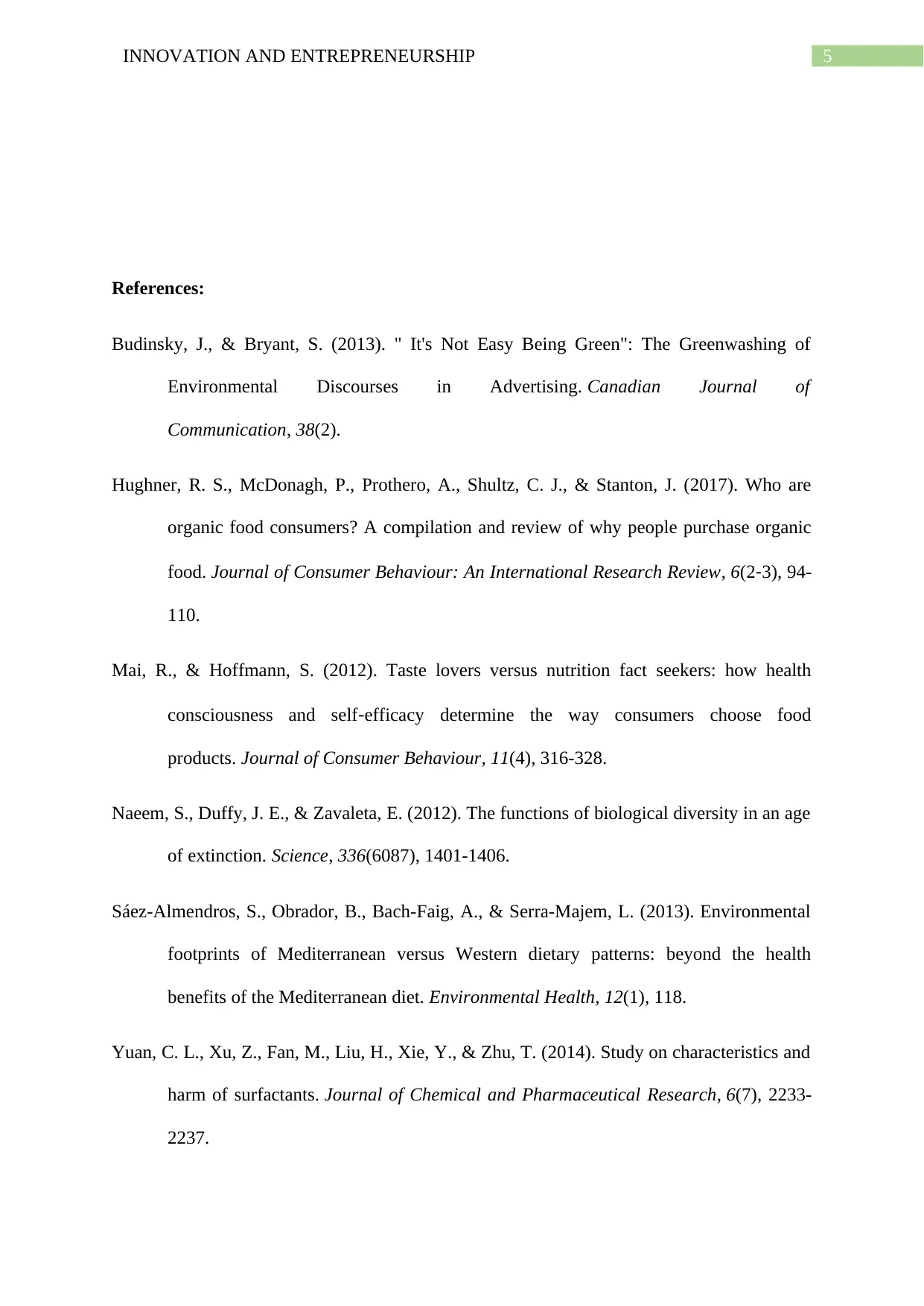
5INNOVATION AND ENTREPRENEURSHIP
References:
Budinsky, J., & Bryant, S. (2013). " It's Not Easy Being Green": The Greenwashing of
Environmental Discourses in Advertising. Canadian Journal of
Communication, 38(2).
Hughner, R. S., McDonagh, P., Prothero, A., Shultz, C. J., & Stanton, J. (2017). Who are
organic food consumers? A compilation and review of why people purchase organic
food. Journal of Consumer Behaviour: An International Research Review, 6(2‐3), 94-
110.
Mai, R., & Hoffmann, S. (2012). Taste lovers versus nutrition fact seekers: how health
consciousness and self‐efficacy determine the way consumers choose food
products. Journal of Consumer Behaviour, 11(4), 316-328.
Naeem, S., Duffy, J. E., & Zavaleta, E. (2012). The functions of biological diversity in an age
of extinction. Science, 336(6087), 1401-1406.
Sáez-Almendros, S., Obrador, B., Bach-Faig, A., & Serra-Majem, L. (2013). Environmental
footprints of Mediterranean versus Western dietary patterns: beyond the health
benefits of the Mediterranean diet. Environmental Health, 12(1), 118.
Yuan, C. L., Xu, Z., Fan, M., Liu, H., Xie, Y., & Zhu, T. (2014). Study on characteristics and
harm of surfactants. Journal of Chemical and Pharmaceutical Research, 6(7), 2233-
2237.
References:
Budinsky, J., & Bryant, S. (2013). " It's Not Easy Being Green": The Greenwashing of
Environmental Discourses in Advertising. Canadian Journal of
Communication, 38(2).
Hughner, R. S., McDonagh, P., Prothero, A., Shultz, C. J., & Stanton, J. (2017). Who are
organic food consumers? A compilation and review of why people purchase organic
food. Journal of Consumer Behaviour: An International Research Review, 6(2‐3), 94-
110.
Mai, R., & Hoffmann, S. (2012). Taste lovers versus nutrition fact seekers: how health
consciousness and self‐efficacy determine the way consumers choose food
products. Journal of Consumer Behaviour, 11(4), 316-328.
Naeem, S., Duffy, J. E., & Zavaleta, E. (2012). The functions of biological diversity in an age
of extinction. Science, 336(6087), 1401-1406.
Sáez-Almendros, S., Obrador, B., Bach-Faig, A., & Serra-Majem, L. (2013). Environmental
footprints of Mediterranean versus Western dietary patterns: beyond the health
benefits of the Mediterranean diet. Environmental Health, 12(1), 118.
Yuan, C. L., Xu, Z., Fan, M., Liu, H., Xie, Y., & Zhu, T. (2014). Study on characteristics and
harm of surfactants. Journal of Chemical and Pharmaceutical Research, 6(7), 2233-
2237.
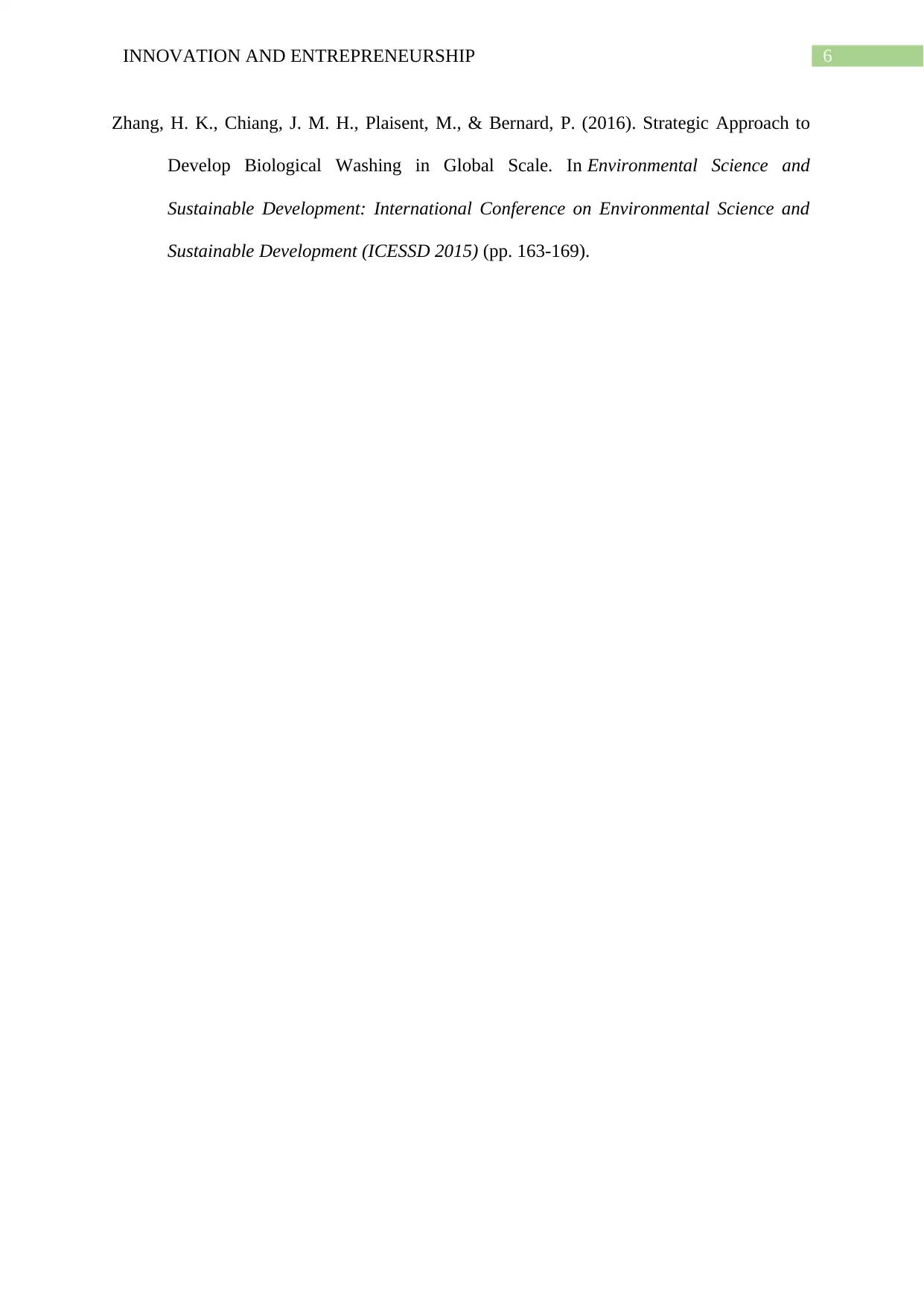
6INNOVATION AND ENTREPRENEURSHIP
Zhang, H. K., Chiang, J. M. H., Plaisent, M., & Bernard, P. (2016). Strategic Approach to
Develop Biological Washing in Global Scale. In Environmental Science and
Sustainable Development: International Conference on Environmental Science and
Sustainable Development (ICESSD 2015) (pp. 163-169).
Zhang, H. K., Chiang, J. M. H., Plaisent, M., & Bernard, P. (2016). Strategic Approach to
Develop Biological Washing in Global Scale. In Environmental Science and
Sustainable Development: International Conference on Environmental Science and
Sustainable Development (ICESSD 2015) (pp. 163-169).
1 out of 7
Related Documents
Your All-in-One AI-Powered Toolkit for Academic Success.
+13062052269
info@desklib.com
Available 24*7 on WhatsApp / Email
![[object Object]](/_next/static/media/star-bottom.7253800d.svg)
Unlock your academic potential
© 2024 | Zucol Services PVT LTD | All rights reserved.



